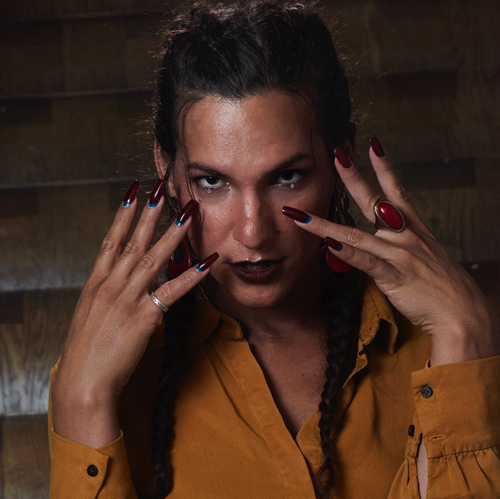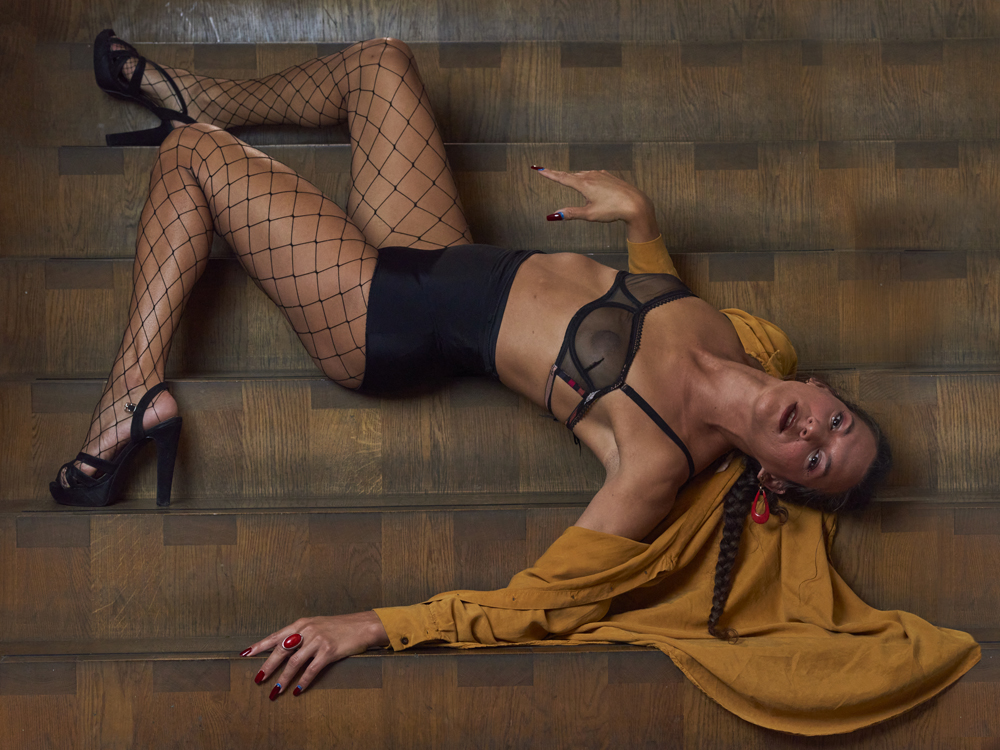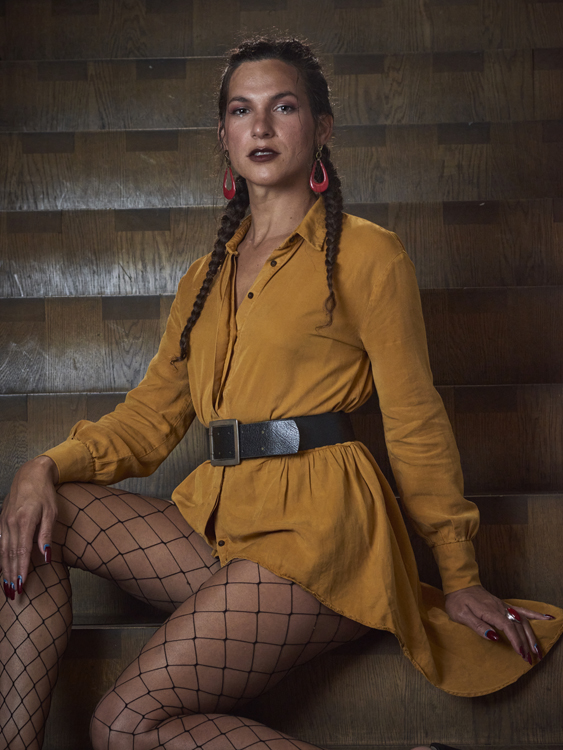
Mavi Veloso – from country girl to performance artist
Photography Jasmine de Vries
Mavi Veloso is a performance artist who, like no other, embodies the concept of trans art. Her work is transdisciplinary: in her performances – live or on video – visual art, dance, theatre, song and spoken word come together. With her work Mavi explores relations between artist and audience, between performativity, transfeminism and gender politics, decolonization, resistance and resilience. Mavi graduated in visual arts and continued studies including a Master of Voice at the Sandberg Institute in Amsterdam. Her work has been performed and shown in both the underground scene (in São Paulo, Brussels, Berlin, Amsterdam) and in museums (VanAbbemuseum, Stedelijk Museum Amsterdam).
Like Mavi, I’m from Brazil. In my early twenties I left my country for Europe, Italy, to move to the Netherlands after seven years. Following my love. Since living with him in Amsterdam, I have been actively involved in bicultural transgender emancipation in the Netherlands. In the summer of 2021, I spoke to Mavi about this in her Instagram video series TrannyCast. This conversation was a closer acquaintance with my ‘trans sister’. Our shared experiences and her views and energy touched and inspired me. Our conversation and the interview I did with her for Trans magazine form the guideline for the portrait below.
Growing up
“I was born in a very small town called Pacaembu, in the state of São Paulo in the southeast of Brazil. In this region it is very warm almost all year round. When I was about three years old, we moved to the countryside in Minas Gerais, wich is in another state. My father was a farmer. My two year older brother and I helped out a lot in the fields, we played on the farms and frolicked in the mud after it had just rained.
Growing up as a trans girl in the 90s in Brazil meant a lot of different things for me. Positive, but also many negative and traumatic. Living in the countryside allowed me to connect strongly with nature: I had a lot of room to move, could climb trees and swim in rivers. At the same time, it was a place where machos, conservative ways of thinking, stereotypes and oppression prevailed.
Growing up in that time and place was confusing. I constantly felt like I was doing something wrong and learned from an early age to hide the things I enjoyed doing. Playing with dolls or the fact that the other boys wanted to do naughty things with me. Most of the time I felt like I was playing a role and was pretending, or that I was lying so as not to get caught.
Sometime in my teens I had to move to the city to continue my education. In Londrina, in the south of the country, I went to study fine art. In addition, I was always busy with theater, dance lessons, circus. It was only at the end of my studies that it actually turned out to me that it was more interesting to work multidisciplinary, merging and mixing all those forms of art. After my education I moved to São Paulo, where I lived for about three and a half years before coming to Europe. Wow, when I talk about it like that it all sounds so simple and easy!
Artistic Child
As a young child, I approached rural life in an artistic way, even though I had no idea what that meant. I spent hours at a time at the table, drawing pictures and making up stories about female characters: little princesses, witches, mermaids… Oh my gosh, it really does sound like a cliché. But it is true that from an early age I had fun making up stories. I put on my mom’s clothes and climbed on top of the couch and pretended that was my stage. Then I danced and sang and imagined I was a superstar. The moment my mother caught me for the first time was very embarrassing. I think that’s why she stopped wearing skirts, high heels and jewelry.
The artistic in me allowed me to escape the masculine reality that was imposed on me. When I was playing under the trees behind our house, I always imagined another universe in which my femininity lived. My fantasy has given me a strong sense of aesthetics.

Becoming a woman
I’ve always been a woman in a way, but it took me a long time to realize that. I was treated like a boy, had to help my father in the fields. But then I always made sure to get my hands on some corn so I could play with it as if it were my dolls. Then I made pigtails in the hair of corn and things like that. Or I snuck into my mother’s closet for her clothes and earrings, necklaces, heels. I was punished and condemned for my feminine behavior by my family, neighbors, friends at school. I had to suppress and hide my desires.
At that time, we didn’t have as much information on the subject as the children and teenagers of today. We didn’t have internet yet. As a child I sometimes saw travestis walking in the city, I was taught to be afraid of those “monsters.” Two decades had passed before I recognized the possibilities of becoming a woman.
At first I thought I was a gay boy. When I started my university, far out of sight of my parents, I started to see the world from a completely different side. I hooked up with other boys, other guys. It was like, wow, I can do that?! Some time later in São Paulo I started experimenting with more feminine clothes and wearing high heels and nail polish, letting my hair grow out. It felt radical and like I was doing something I shouldn’t, but at the same time it also felt like I was given freedom that I had never experienced as a child or young teenager. The term non-binary didn’t exist yet, or at least it wasn’t that popular. I remember people calling me androgynous, that made me so proud! People saw that I was different and that being different was first understood in a certain way.
Everything for me came a bit later. I was already 29, although I still felt like an adolescent, when I started to experiment hormones. For years I was slowly processing the idea of femininity and masculinity and switching between the two.
But suddenly in 2014 I just couldn’t handle what I was living anymore. I went to a pharmacy in the center of São Paulo and bought my first shots of Perlutan. In Brazil that’s quite common within the trans communty, it’s a very popular hormone used for generations already. I researched a lot, read a lot about female hormones and their effects… But the big reference was actually my friend Glamour Garcia during the short time we lived together. Ofcourse I didn’t go to any doctor, that was not an option. At that time, there was no medical assistance at all in Brazil for people who wanted to transition. It was actually something you saw or learned from other girls. Before I started, I was very scared, but at a certain point I couldn’t handle it anymore, I felt that I needed change, physical changes.
This transition process is closely related to my migration process from Brazil to Europe. I think leaving my country and my family behind gave me a lot of courage to take that personal big step too. In addition, the idea that I was going to a place where maybe there would be less violence and where maybe i could find better opportunities for self-fulfillment gave me some confidence and hope.
Uncertain journey
I felt like something in my life wasn’t complete, like something in me needed to be awakened, like i needed to challenge mysef with somenthing else. I was involved in a number of projects in São Paulo, but when I had gathered enough energy I started looking for an escape. Moving to Europe was not a thoroughly prepared plan. I left hurriedly, with barely any money in my pocket, for Brussels to follow a course in the performing arts. That was sort of an excuse I made up for myself, but and it also got me my visa to stay in Europe. And then I started to turn my transition process into an art project.
Like so many people who come from an underdeveloped country, I was stunned when I arrived in Brussels. I had fantasized about how this would be the solution for my life. However, that dream did not last long. As an androgynous person, that’s what they called me at the time, with an image that was not exactly male or female, and as a ‘stranger’ entering ‘the old world’, I was constantly dealing with intricacies. Add to that the difference in climate and culture, and a certain roughness in the way people interact with each other here… The hormonal changes also made me react more emotionally and sensitively to everything. I cried a lot and after two months I wanted to go back to Brazil. But little by little I learned to deal with all the changes. I met many dear people, some of whom lived in similar situations. They became my new family.
After living in Brussels for two and a half years, I wondered if I would have the courage to go back to Brazil and start all over again. Politically and economically, my country became more and more complicated. Miraculously, I then managed to qualify for a master’s degree in Amsterdam, for a program that had everything to do with my research into voice, performance and gender. That’s how I ended up in the Netherlands and I’ve been living here for four and a half years now.
Travesti Biologica
During that Master of Voice at the Sandberg Institute I did a multidisciplinary creative process, an important step to what would become Travesti Biológica project. I’ve been in the process with it since 2017, slowly composing the lyrics and producing the music, learning while doing. Since 2019 I did a number of try-outs with that with pocket shows, fragments of performances, experimentations . In 2020, I decided it was time to bring it all together in an 11-track music album followed by a series of video performances.
Travesti Biológica comes as a question and reaction to a white, normative, sexist, cistem that insists in questioning the authenticity of trans men and women. That insists to place themselves not as “cisgender people” but as “normal people”, as “biological” men and women. Trans, intersex, non-binary people are equally real, normal, natural, biological men and women too.
The travesti biológica identifies as female. She can have both a biologically female and male penis, or both, or neither. She may have a transgender penis. She can have a vagina, either female or male, or none at all. She doesn’t care about genitals. She makes herself strong as a woman, she makes herself strong as a versatile person.
I am working on this music album with several queer artists with a migration background. Through the songs, the performance and the audiovisual material we try to come up with ways to tell our stories about our existence and our resistance to the ruling order. Either by using radical imagery and talking about violence, other times we’re discussing everyday situations, or talking about love and the need for affection, which we also have. In a way, through the songs and through the videos, we create a kind of manifesto to make people aware that we are here, we’re queer, we have no fear and that we are just as biological and natural as anyone else.
Now that we’re making the visual album, I think it’s going to be really exciting. It is an ambitious project. I am very grateful that I can count on many dear friends, “siblings.” Most live in the Netherlands, some in Germany, and some have worked remotely from Brazil. Although we share several common processes, we all have different perspectives and life experiences, given the particularities of the personal and artistic journey we went through as queer, women or trans people when we arrived in Europe.
We make this story, this project together. Of course I give a lot of direction in the process, but everyone’s specific knowledge and personal experiences as a queer person help to complete the project in various ways.
Our plan is to release the music around the end of January or early February 2022 and the videos will come out in sequence. We also have a number of launch events planned in Amsterdam and other Dutch cities. I hope that after the release we can tour Europe and even Brazil. The album is partly in English and partly in Portuguese.
Ambitions
My brain likes to focus on the now, on what I’m doing right now. I wish Travesti Biológica much brilliance and success for all involved. I really hope that the strong and important message in the songs and the videos resonates in people’s minds and hearts.
I think being an artist is all I see myself doing. Very, very often I have been disappointed by the fragile situation in which an independent artist has to live. I have often been angry, then I wanted to give up everything and look for another path and a different profession. But I always came back to this world, for me it is both a curse and a blessing.
Despite being such a poorly recognized and underpaid existence, I still believe that art is one of the most powerful and important tools for production of knowledge.
And when you see that queer transfeminine artists are conquering more space in, say, the music world, which has always been mainly defined by white men, and you see that this also resonates in the society that supports women and gays and trans women to get more of being heard gives me hope to keep making my art. It reminds me of the goal I work towards: I work for transformation, for a better world, a world without violence because of our bodies, a world in which my ideas and the way I am, my gender, my skin color, my sexuality, my eroticism , will also be respected and loved, just as I am.’

